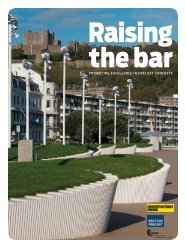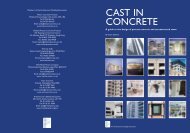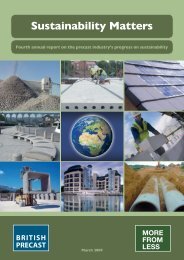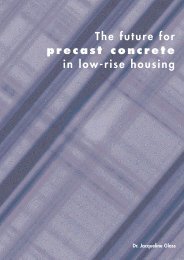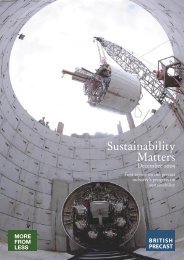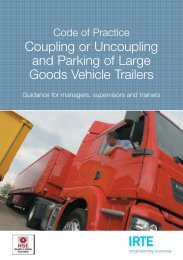The voice of concrete products - British Precast
The voice of concrete products - British Precast
The voice of concrete products - British Precast
Create successful ePaper yourself
Turn your PDF publications into a flip-book with our unique Google optimized e-Paper software.
PRECAST CONCRETE SPECIAL EDITION<br />
Figure 6: Failure <strong>of</strong><br />
deep recess beam by<br />
yielding <strong>of</strong> diagonal<br />
bars and local<br />
splitting <strong>of</strong> <strong>concrete</strong> in<br />
compression zone.<br />
6mm, V-funnel = 9 seconds. Density = 2380kg/m 3 , 28-day<br />
cube strength = 66MPa.<br />
Small-scale multi-axial tests showed that it was necessary<br />
to use 1% fibre content to achieve the mean tensile<br />
stress required in the half-joints.<br />
Full-scale shear test beams with shallow or deep<br />
recesses (see Figures 5 and 6 respectively) gave the ultimate<br />
shear capacities shown in Figure 7. <strong>The</strong> inclusion <strong>of</strong><br />
1% volume <strong>of</strong> steel fibres was found to be effective in<br />
replacing at least 50% <strong>of</strong> vertical or horizontal reinforcement.<br />
However, the replacement over diagonal<br />
reinforcement in the deep recess was, as expected, not<br />
effective, indicating that fibres are suitable only for replacing<br />
vertical and horizontal bars. Steel fibre contribution is<br />
due to fibres’ bridging action and an increase in compressive<br />
resistance due to fibres arresting the propagation <strong>of</strong><br />
cracks in the compressive zone.<br />
Semi-empirical equations for predicting the shear<br />
strength <strong>of</strong> precast SCC and SFSCC beam half-joints have<br />
been developed (3) . <strong>The</strong> analytical model based on the<br />
crushing <strong>of</strong> the <strong>concrete</strong> strut was found to suit the shallow<br />
recess beams, while the equations for deep recess beams<br />
were based on yielding <strong>of</strong> reinforcement.<br />
Data points in Figure 7 show that these equations give<br />
good correlation with the experimental results. <strong>The</strong> standard<br />
variance is 6% and 3% for the shallow and deep recess,<br />
respectively. All equations are improvements compared<br />
with the equations published by the PCI Design<br />
Handbook (4) and RILEM (5) .<br />
Concluding remarks<br />
<strong>The</strong> research presented in this paper has demonstrated a<br />
wide range <strong>of</strong> applications for precast <strong>concrete</strong> used in<br />
combination with other structural and material mediums.<br />
<strong>The</strong> key findings are:<br />
• Composite action between precast hollowcore slabs<br />
can be achieved under widely different surface textures<br />
and preparations. Although there are clear<br />
indications as to which permutations perform best, all<br />
full-scale tests exceeded code limits or design values.<br />
• <strong>Precast</strong> hollowcore slabs can be used to provide the<br />
horizontal floor diaphragm in steel frames, without<br />
the need for bracing, and in spite <strong>of</strong> the fact that under<br />
combined bending and diaphragm actions, shear<br />
studs may lose more than half their uniaxial capacity.<br />
• <strong>The</strong> research on precast half-joints has demonstrated<br />
the success <strong>of</strong> replacing considerable quantities <strong>of</strong><br />
congested reinforcement with a small quantity <strong>of</strong><br />
steel fibre, without loss <strong>of</strong> strength, and in some cases<br />
improvements in ductility.<br />
n<br />
References:<br />
1. BRITISH STANDARDS INSTITUTION, BS 8110. Structural<br />
use <strong>of</strong> <strong>concrete</strong>. Code <strong>of</strong> practice for design and<br />
construction. BSI, 1997.<br />
2. BRITISH STANDARDS INSTITUTION, BS EN 1992-1-1.<br />
Eurocode 2: Design <strong>of</strong> <strong>concrete</strong> structures. BSI, 2004.<br />
3. NOOR, R.M. Steel-fibre self-compacting <strong>concrete</strong> in<br />
precast <strong>concrete</strong> half-joints. PhD <strong>The</strong>sis, University <strong>of</strong><br />
Nottingham, 2008.<br />
4. PRECAST/PRESTRESSED CONCRETE INSTITUTE. PCI<br />
Design Handbook on <strong>Precast</strong> and Prestressed Concrete.<br />
PCI, Chicago, Illinois, USA, 1999.<br />
5. RILEM TC 162-TDF. Final recommendations <strong>of</strong> TC 162-<br />
TDF, Test and design methods for steel fibre reinforced<br />
<strong>concrete</strong>, σ-ε design method. Materials and Structures,<br />
Vol.36, 2003, pp.560–565.<br />
Figure 7: Comparison<br />
<strong>of</strong> experimental test<br />
results with analytical<br />
equations for deep<br />
recess beams.<br />
Reproduced f ro m CONCRETE December 2008/January 2009 © <strong>The</strong> Concrete So c i e t y, 2008 31









